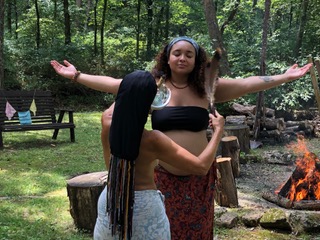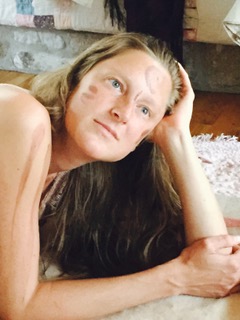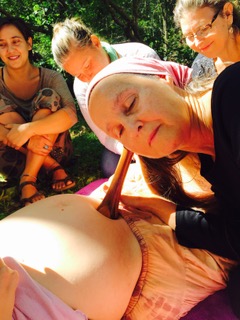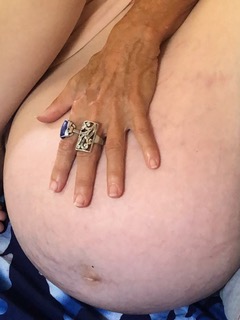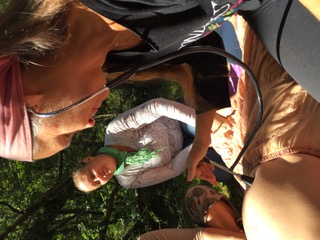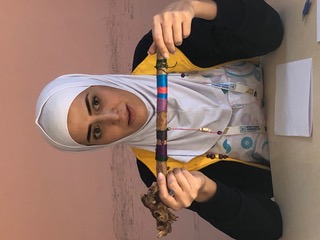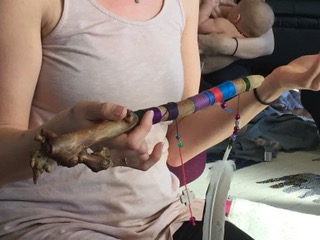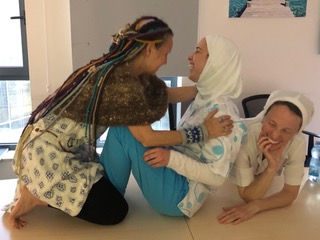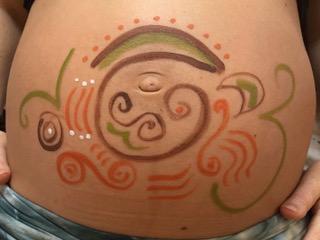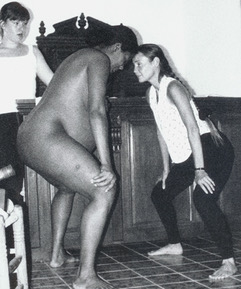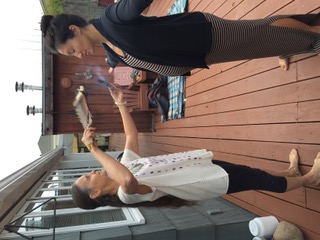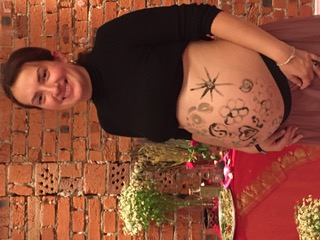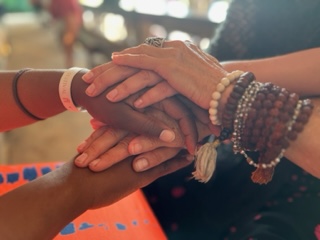Village Prenatal: Bringing Birth Back to Community
- Admin
- Nov 23, 2023
- 11 min read
Village Prenatal
Bringing Birth Back to Community
by Sister MorningStar
(First published on midwifery today)
I had to trot to keep up with Doña Juanita on the footpath leading to our first prenatal home visit of the day—a first time mother who had been born into Doña’s hands some 17 years past. Doña Juanita was in her 60s—my elder at the time—small, fierce, and focused. She brought nothing with her but her hands and a lifetime of wisdom born of experience. Every mother had her own rebozo for the work of aligning bones or baby. Every humble dwelling had oil for the sobada (massage) to relax muscles while the wimyn spoke of things not to be repeated outside these walls or moments. The mothers fed Doña and in this way she knew what they ate, both quality and quantity. The family herb gardens informed Doña what would be available, if needed, when the time for birth arrived. A walk around the garden let Doña see how the mother moved, got down and up, breathed with exertion, and how she was in relation with neighbors passing by. Nothing escaped Doña Juanita as she familiarized herself with the personality, needs, ways, and hopes of each mother. Doña Juanita kept her eye on the mothers. I kept my eye on Doña Juanita.
We didn’t follow a clock. The time we spent at each home matched no other. If we didn’t get to all the mothers, we started out again the next day. The wimyn knew Doña Juanita would get to them eventually. The rhythm was guided by need. All I could do was observe. Observe. Observe. Doña did not teach with words or books, as she did not read or write. You either saw her hands form over the baby in the womb or you saw her study the mother’s skin or you noticed how she asked a timely question; or you missed it. For 15 seasons I returned to observe. The other traditional midwives worked the same. I prayed their sacred ways would not be lost on me. I determined to learn all I could.
The best prenatal care I ever witnessed was in the villages during those 15 years in Mexico and later around the world where the traditional midwives made their homes in the midst of the community they served. Mothers were fed, touched, helped, and listened to. For hours.
Prenatal care is something the mother does. Every day. It is what she eats, how she sleeps, her walks in the woods or parks, her depth of relationship, how she handles her daily routines and stresses, how she poops. It is the care she is giving herself to grow her baby as best she can. A prenatal visit with a professional is not prenatal care. It is assessing prenatal care.
Group prenatals are amazing and useful and have the advantage and potential of connecting birthing mothers with one another where inspiration, stories, and education organically plant good seed. A village prenatal is not a group prenatal.
Over a decade ago I decided to design a village prenatal (1). I wanted to gift the best of all I learned in the service of caring for pregnant mothers. I wanted to return birth to their community. I started with the premise that all pregnant wimyn would be welcome, independent of where, how, or with whom they planned to birth. I invited other wimyn, who had birthed in power and could bring positive story and role modeling. No one was to offer professional comments or advice. The mother had her own plan for her birth. The day was set aside to honor, nurture, nourish, and care for her as a holy womyn carrying the future of her tribe and our world. Such a sacred womyn is she, and we came together with deep respect. Each womyn brought a nutritious dish to share, a music maker, her own sitting pad, an icon for the altar, and an open and willing heart.
That was over a decade ago. I have traveled the world sharing this simple model and building the confidence for wimyn to gather and offer a village prenatal in their community. What one village can do, all villages can do. It can be done with only one mother and a few handmaidens. Ideally there are three to four pregnant mothers. I have held circles with dozens. The larger the number, the more handmaidens are needed to hold the sacred space and tend to the needs of the holy mothers. The flow itself is simple. Sacred, really.
I welcome each womyn by offering an anointing with oil I have made from the wild roses on my Holyland. I say something like: “You are a preserver of all things sacred in your world. Be welcomed here!” If a mother is tired or has many children, we put her in a rose petal bath with a handmaiden and tea and candle to relax. The gathering room is set up with beauty, flowers, altars, candles, drums, and quilts, and is calm, comforting. We sing many songs and chants that enliven the spirit, empower the mind, welcome the baby, connect the community. While we share a foot rub, we tell positive birth stories or tricks and tools unique to motherhood that helped us find our power in birth. Sometimes we share stories about birthing positions, breathing, cords, placentas, breastfeeding, diapering, siblings, the early hours, days, weeks, relationships, self-care. We talk about the ways we ask for help and keep good food coming in and laundry going out.
There are two questions I ask the mothers. The first question is, “What is your ideal birth? If you could birth any way you wish, not thinking about what is possible, what would it look like, sound like, be like?”
I hand the mother one of my native-made talking sticks (2) and we of the elephant circle (3) listen. When she finishes her truth-telling, we respond, “May it be so!”
The second question is: “What is a current fear, worry, concern, doubt, trouble?” Again, I hand her the talking stick and we listen. Our response is, “We are here for you!”
If the mothers are willing, we talk to their babies, listen to their babies, play with their babies. No dopplers. We use only fetoscope, womb chime (4) or our ear. In this way, as the years go by, the community begins to learn how baby feels when the head is down. The community learns what baby sounds and placenta sounds are like during early, middle, and late pregnancy. Mothers love for people to love their babies. We are not assessing anything. We are getting to know this new life that will become part of our belonging. We use mud or nontoxic colors to draw beautiful art over the baby belly. We sing to baby. We sing to mother.
Finally we gift the mothers a blessing, often using a feather in a bowl with crystal and water. We might offer one word that will become an echo of support when she births and needs it most. We dance around the mothers and sing a power song. It is common for us to close with a howl. A calling of the pack, which baby will recognize one day. We feast. All leftover food goes with the mothers. We promise to meet again.
Some mothers feel the most comfortable with a highly medical prenatal team. Others with no one professional in their birthing space. Most mothers desire something in between.
Mothers need such freedom to choose and to be respected for their choice. There could never be one right way for all wimyn, in my way of thinking. How can we standardize care with such immense variance of culture and need worldwide? Maybe I will share some of what I do in a private prenatal agreement. Maybe sharing will be a good thing. Maybe it will be a confusing thing. Maybe it will serve someone.
When I interview a mother and her family to discern if we are right for one another, I allow three or more hours for our first talk. We never make a decision that first visit. It is such an important "yes" to make for both of us. We part with questions to ponder and space to not feel rushed. Birth is not meant to be rushed.
If we decide to work together, I feel myself falling in love with her, her story, her past journey, and the one in front of us. I delight in getting to know her family, her dreams, her concerns, her excitement. Every visit my commitment grows
She is in the river that will carry her to a shore with a baby in her arms. I have agreed to step into that river with her. She might decide to release me from our agreement but I now am committed to seeing the journey through, come what turns or tumultuous waters or smooth sailing it may bring. Here we go. I get excited when I will see her again and I pray for her when my head is on my pillow at night. Long after her baby is born, she will visit my mind, my dreams, my prayers. I will forever be her midwife. It is not unusual for me to be taking her calls through the toddler and teenage years. Maybe, when that baby grows up and needs a midwife, I will be helping again. Like Doña Juanita. Village midwives are a treasure.
The first few visits are rich with tea, time, tissue, talk, and building trust. Like the village midwives I learned from, I like to have my warm oil ready for a foot rub while we talk; tea and snacks ready; a calm, clean, homey space to build honesty. I have noticed over the years that it takes all this and more for the hidden life to come forth. The secrets. The truths that she doesn’t want written down in the chart but very much affect how she can open up, loosen up, be turned inside out.
I notice how she walks up my steps. Is she energetic today? Cheerful? Quiet? Out of character? Talkative? Full of questions? Too compliant? Too demanding? The first moments are essential to know what the visit needs to hold.
I like to study her body from head to toe. “May I touch you?” I ask. I like to make it fun to talk about hair, skin, senses, strength and flexibility of her joints, heart and lung sounds, neuro responses, gait. If I take her hand in mine, I notice if she looks away or focuses with me. Watching with 1000 eyes, I like to study her hand: her nails, her skin color and tone, her capillary refill, her pulse, her scars, her hydration, her joint flexibility. The outside tells me so much about the inside. We might check a BP or pee as the visits go along, especially if she feels poorly. I hear the echo of my beloved apprenticeship mentor. “An assessment tool should only confirm what you already know from your clinical/direct observation.” The mother and I are not in a hurry. What we don’t finish in one visit can wait for the next. We are learning how to create sacred space together. I ask her to keep a dream journal.
Each time we to listen to baby and placenta—the first mothe—and how they are growing. I am making friends with this little creature. I like to speak a different language than the one spoken in their household. Babies are curious. They become active with different sounds, especially the human voice and new languages. I don’t use a Doppler. They haven’t been proven safe for the unborn or for me. I have my fetoscope, womb chime, and ear. I listen to the mother describe her baby moving. I love listening to placentas, amniotic fluid, uterine arteries, and, of course, womb babies. I pass the fetoscope to mother and we talk about what we are hearing. We are building a bridge to share knowledge, skill, confidence, and love for the great work ahead. She knows more about her body and baby than I do. The bridge is built from the two sides toward the center. I am giving my all to build a strong bridge from my side toward her. Our bridge is built of trust, respect, listening, time, honesty, growing confidence. It takes such patience and devotion. From both of us.
Dr. White, a homebirth midwife in Chicago back in the ’70s used to say, “If you go into labor with a healthy mother and baby, that is what you usually come out with.” Dr. Watkins, a homebirth family doctor in Missouri guided us often with such truths as, “Know normal and all i’s variations. Don’t study abnormal. Know normal and if it isn’t normal, then seek help.”
Because I studied with many different cultures and midwives, I learned many variations of normal and how to bring marginal normals back into center with simple actions like food as medicine, gentle supplements, fresh air walks, nature, pure water, deep sleep, help in the home, spirit strength.
One of my favorite visits is the home visit in the last month or so before baby might come. We meet with everyone who has been invited to the sacred moment of birth. We talk about the mother's highest ideals. We review supplies and tasks and exchange phone numbers. We roleplay. We eat together. We review any themes or patterns that have taken form during the pregnancy that might become obstacles during labor and birth. We address any unanswered questions. We sing or pray together. The most important part of a prenatal visit is talking about postpartum. Now we are so close. We review the postpartum plan to see if it is “fit for a Queen”.
Every week we watch the baby and excitement grow. The last weeks reveal how strong our bridge of understanding, commitment, respect, and communication has been built. Sometimes it is tested with unexpected difficulties or a late baby or a long labor or swinging emotions. Early or late, easy or challenged, prepared or not, wet with sweat and arms reaching, baby comes. The great story that will ring out for many generations has been written. I feel a great honor to have been called into the story.
Of late I have been wondering how much good could come from reducing prematurity, infant and maternal mortality, and save our mothers from postpartum isolation and sorrow leading to disastrous depression. It is a simple action. The village midwives did it as part of their prenatal care. Home visits. I wish the medical and midwifery communities would simply add home visits by a nonprofessional, caring mother who had recently birthed. A world of good would come to both wimyn. We would see a dramatic and immediate reduction in the sad stories that are lacing the generations of our people.
Meanwhile, returning birth to the community with village prenatals may be the cornerstone of preserving simple and sacred birth.
Doña Juanita has now walked on. Most of the wimyn in her village of Saletrillo go to the government hospitals to have their babies. The professional care does not include rebozo or sobada or tea or soul talk. It is hard to know what has been gained. It is easy to name what has been lost.
My phone rings. “Sister, will you talk to me? I am Andrea. I live in Nicaragua. I am an American and this is my first baby. I don’t know anything about birthing babies. The doctor says I need to schedule my cesarean section. She says the risks are too high. First babies must be delivered this way or they will die and my bottom will never be right again. I am due in 3 weeks. Will you talk to me?” (Andrea had read my book The Power of Women.)
“Is your baby moving?” I ask. “Do you feel healthy and strong? Do you have help after birth?”
“Yes, yes, yes,” she tells me. “I just don’t want to be cut wide open!” she declares with conviction.
I settle in for a change in my morning. I step into the river with her. I tell her, “Please, get a cup of tea. I will, too. We will talk. You can tell me about how you were born.” (5)
It is the modern world. We are a global village. There is no one right way to give or get prenatal care. As of old, may the midwives be protected. In the modern world, may their wisdom ways be preserved. For the next generation. And the next. The torch has been passed to us. To whom and what will we pass on?
Notes:
1. A description and outline of the Village Prenatal can be found on my website: sistermorningstar.com.
2. A Talking Stick is the Native way of speaking truth while others listen without interruption or comment. It is a stick adorned with yarn, stone, feather, bead, etc. It is tribal sacred.
3. Elephants circle around a birthing mother and thus the image.
4. Womb chime is my word for Pinard.
5. Andrea went on to have her baby some three weeks later at home in Nicaragua. She told her doctor, “I don’t know about all the risks to having a cesarean section birth, but there has to be some risk to you cutting me wide open. I am going with the natural risks.”
Sister MorningStar has dedicated a lifetime to the preservation of instinctual birth. She birthed her own daughters at home and has helped thousands of other women find empowerment through instinctual birth. She is the founder of a spiritual retreat center and author of books related to instinctual and spiritual living. She lives as a Cherokee hermitess and Catholic mystic in the Ozark Mountains of Missouri. Visit her on the web at: www.sistermorningstar.com.
The Power of Women: Instinctual Birth Stories: When women embarked on their journey into womanhood and motherhood, stories from their grandmothers, great-grandmothers and ancestors came forth through songs, stories and what appeared as mythological tales. Upon hearing these stories, women became empowered to do what all women from which they came were able to do: give birth instinctually.



